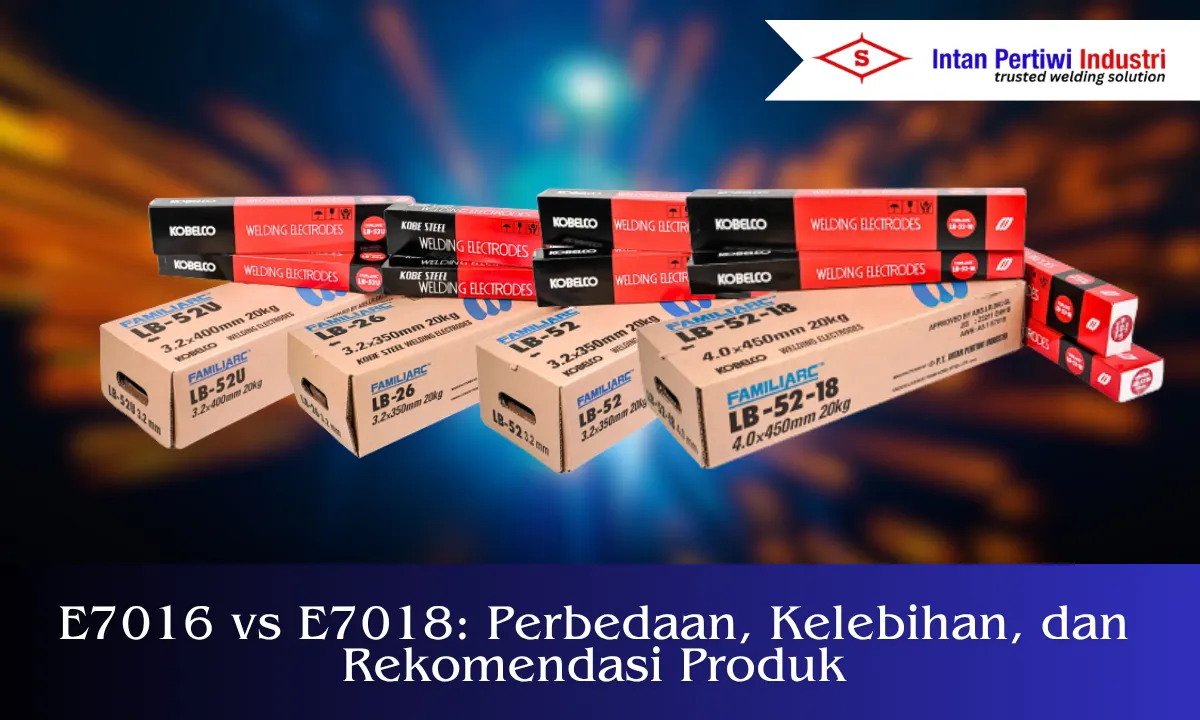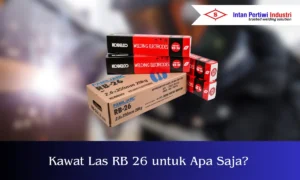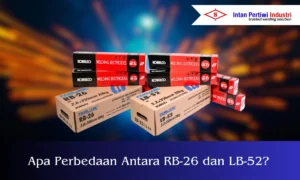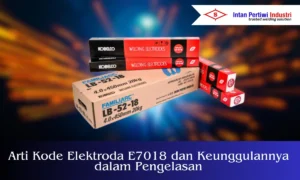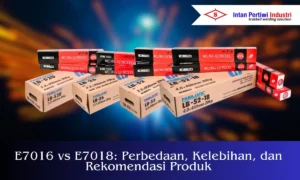Selecting the right low hydrogen electrode often determines the final outcome of a project. This article discusses the e7016 vs e7018 in clear, practical language to help fabrication and maintenance teams make quick decisions.
You'll find differences in coating characteristics, pool control, and deposit rates, along with examples of use in flat, horizontal, and uphill positions.
Table of Contents
ToggleQuick Summary: E7016 vs E7018
E7016 and E7018 are in the same tensile strength class. The main differences are in the coating characteristics and the priority of the results. E7016 stands out in pool control, especially in uphill positions.
The E7018 excels in deposition rate for flat-position production. If stability and heat control are your focus, choose the E7016. If throughput and full bead appearance are your goals, choose the E7018.
The final decision should still be validated through a short coupon test to align with the applicable WPS.
What Do E7016 and E7018 Mean?
The letter E indicates an electrode for the SMAW process. The number 70 indicates a minimum tensile strength of 70 ksi. The number 1 indicates support for all positions.
The last two digits describe the coating type and arc characteristics. In practice, this implies discipline regarding diffusible hydrogen control, proper storage practices, and re-drying procedures when necessary.
With this understanding of the code, the team can connect paper specifications with the reality of welding in the workshop and in the field.
Coating and Metal Recovery
Character E7016
The E7016 uses a low-hydrogen base coating that helps keep the pool narrow and easy to control. This characteristic facilitates control of the bead shape during vertical and overhead movements.
Regular penetration and coherent slag help produce a neat joint profile so repairs are minimal.
Character E7018
The E7018 combines a basic coating with iron powder. This enhances metal recovery, resulting in higher deposits per pass. This results in increased productivity in both flat and horizontal positions.
The beads tend to be full and the joint edges appear tight. This is advantageous for repetitive fabrication work with tight deadlines.
Current, Polarity, and Machine Suitability
General Recommendations
Both classes can be used on both AC and DCEP. Arc stability is usually more consistent on DCEP as long as the machine has adequate OCV and the cables are in good condition.
Start with the lowest current that stabilizes the arc. Gradually increase it until the bead fills without excessive sparking or undercutting.
Practical Setup
Use a diameter appropriate to the material thickness. Ø2.6 mm is suitable for thin plates with tight heat control. Ø3.2 mm is suitable for general work. Ø4.0 mm and Ø5.0 mm are used for thicker materials and multi-pass applications.
Validate the setting through coupon testing on scrap material before entering full production.
Welding Positions and Techniques
E7016 for Challenging Positions
The E7016's vertical and overhead designs provide a responsive pool, making it easier to manage. Short stringers with a short bow length help retain heat and reduce the risk of porosity.
The calm swinging rhythm helps maintain a uniform bead shape across the phase.
E7018 for Flat Position Production
In the flat and horizontal positions, the E7018 exhibits superior deposition rates. The full bead appearance reduces the number of passes to achieve the target fillet size.
Travel speed can be increased gradually as long as the fillet foot is maintained and no underfill occurs.
Toughness, NDT Testing, and Radiography
Both classes are designed to meet structural quality requirements. Successful NDT testing relies heavily on surface cleanliness, consistent parameters, and control of diffusible hydrogen.
Proper storage and re-drying according to the manufacturer's instructions helps reduce the risk of hydrogen-induced cracking. Document the electrode's exposure time in the work environment so that preventive measures can be taken before quality declines.
Key Comparisons to Note
Technical Criteria
Consider iron powder availability, metal recovery, ease of pool control, machine OCV requirements, and ease of restarting. Also consider your desired bead appearance and line productivity targets.
Operational Impact
The E7016 tends to provide the best control in uphill positions and on joints requiring pool discipline. The E7018 offers high productivity for flat positions and repetitive work. Choose the one that best aligns with your project needs for more time and cost efficiency.
Recommendations Based on Scenarios
When Prioritizing Control
Work dominated by vertical or overhead work is facilitated by the E7016. The narrow pool provides good control space, preventing defects caused by excessively thin pool flow.
When Prioritizing Throughput
Fabrication with a predominance of flat positions tends to be completed more quickly with E7018. The iron powder content increases efficiency per pass, making hourly production targets easier to achieve.
Notes Beyond Low Hydrogen Comparison
For general applications, thin plate E6013 can be considered as per WPS. In the INTIWI product line, the relevant reference is LB 26, which can be found in the referenced products section.
Recommended Products E7016 and E7018
After understanding the differences between E7016 vs E7018, it's time to move on to product recommendations that best suit your project needs.
Class E7016
1. Kobelco LB 26 Welding Electrode
LB 26 is coded AWS A5.1 E7016. This low-hydrogen electrode is designed for steel structures and critical jobs that require good hydrogen control, consistent arc stability, and clean bead results in various positions.
Kobelco LB 26 welding electrode is suitable for construction, pipes, and industrial equipment that require reliable connection quality.
2. Kobelco LB 52 Welding Electrode
LB 52 is an E7016 electrode that prioritizes pool control and arc stability in various positions. Its basic coating helps reduce the risk of diffusible hydrogen, making the joint more resistant to cracking.
This Kobelco LB 52 welding electrode product is ideal for steel structures, work in uphill positions, and applications that require consistent results and easy to achieve a clean bead profile.
3. Kobelco LB 52U Welding Electrode
KOBELCO LB 52U has the code AWS A5.1 E7016 and includes low hydrogen electrodes for carbon steel and tensile strength steel up to 490 MPa.
Its characteristic is excellent arc stability at relatively low currents making it superior for one-side pipe welding or root passes with controlled penetration.
LB 52U is designed to maintain low diffusible hydrogen content, providing good crack resistance and high impact toughness over a wide temperature range, making it suitable for low temperature applications as long as the WPS and manufacturer's procedures are followed.
Class E7018
Kawat Las Kobelco LB 52 18
LB 52 18 welding electrode is an AWS A5.1 E7018 electrode with low hydrogen iron powder type designed for carbon steel and high tensile steel grade 490 MPa.
Welding electrode the iron powder character increases the deposit rate compared to the E7016 grade, so that fillet work and flat position production are faster without sacrificing the toughness of the results.obelco LB 52 18
This electrode is known for its stable arc, neat bead, easy slag peeling, and good x-ray soundness, making it suitable for structures, pressure parts, and pipes that require consistent quality.
Conclusion
In short, the e7016 vs. e7018 comparison boils down to application priorities. The e7016 offers superior pool control for uphill positions and jobs requiring hydrogen discipline, while the e7018 offers high deposit rates for flat-position production with full beads.
Both support structural quality as long as parameters, cleanliness, and storage are properly managed. Choose the one that best suits your WPS and project needs to ensure consistent welding results from start to finish.
To order the products E7016 and E7018 please contact us via WhatsApp or use the contact form provided.


